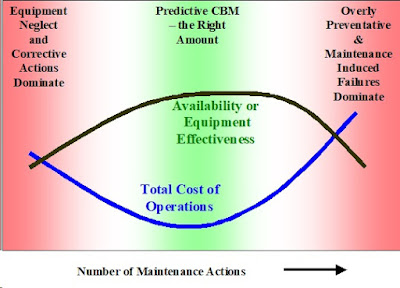Condition-based maintenance
(CBM or CBM+) is a strategy of performing maintenance on a machine or
system only when there is objective evidence of need or impending
failure. CBM is enabled by the evolution of key technologies, including
improvements in - sensors, microprocessors, digital signal processing,
simulation modeling, multisensor data fusion, reliability engineering, Internet of Things (IoT) connectivity, data warehousing, cloud computing, machine learning (ML), artificial intelligence (AI), and predictive analytics.
CBM involves monitoring the health or performance of a component or
system and performing maintenance based on that inferred health and in
some cases, predicted remaining useful life (RUL).
This predictive maintenance philosophy contrasts with earlier
ideologies, such as corrective maintenance — in which action is taken
after a component or system fails — and preventive maintenance — which
is based on event or time milestones. Each involves a cost tradeoff.
Corrective maintenance incurs low maintenance cost (minimal preventative
actions), but high performance costs caused by operational failures.
Conversely, preventative maintenance produces low operational costs, but
greater maintenance department costs. The result is the additional
hidden cost associated with disposing of components that still retain
significant remaining useful life. Such early retirements also drive
more demand for spares and higher procurement costs over the life cycle.
Operational
availability (military) or overall equipment effectiveness (industrial)
is also affected by maintenance choices. Overly corrective or overly
preventive maintenance strategies can reduce true availability through
too much downtime due to maintenance. On the corrective side, running to
failure or near failure typically leads to more significant operational
issues and consequential damage. Lost production, downtime, and more
significant maintenance often result. On the preventive side, the
equipment is often unavailable because it is being more frequently
maintained than optimally required in order to conservatively prevent
failures. There is also a greater likelihood of maintenance-induced
failures, which can have a negative effect on cost and availability. The
more one disassembles or modifies well functioning equipment, the
greater the chance that one will introduce a new problem or confounding
issue.
Implementing better maintenance
practices is driven by the desire to reduce the risk of catastrophic
failures, minimize maintenance costs, maximize system availability, and
increase platform reliability. These goals are desirable for aircraft,
ships, ground vehicles, and industrial manufacturing of all types. Given
that maintenance is a key cost driver in military and commercial
applications, it is an important area in which to focus research and
development efforts and drive continued engineering improvements.
About the Author

No comments:
Post a Comment
Note: Only a member of this blog may post a comment.